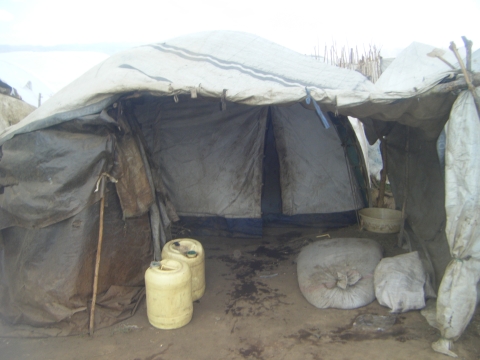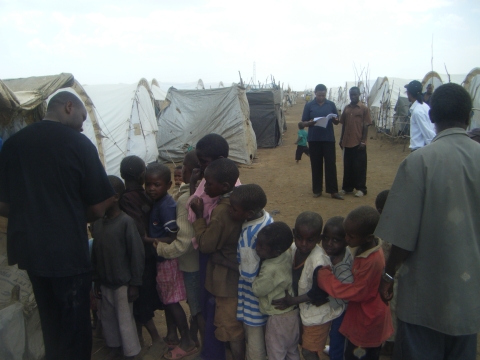
A makeshift "kitchen" at Maai Mahiu. Water is even more scarce than food here, and residents subsist on rations of meal and the occasional "jerri-can" of water.

The view down one of the many rows of tents, provided by the United Nations High Commissioner for Refugees (UNHCR), at the Maai Mahiu IDP camp.

Nairobi Star reporter Wacui Makori interviews a parent at Maai Mahiu as children line up for free "mandazi" or doughnuts.
Editors Note: Rachel Jones visits Maai Mahiu Internally Displaced Persons Camp in Kenya.When I agreed to accompany Nairobi Star Reporter Wacui Makori to the Maai Mahiu Internally Displaced Persons Camp, the date of our journey didn’t register initially. But waking up on the morning of Friday, March 13th, the irony hit me right between the eyes.
My first trip to an IDP camp occurred on July 7, 2007—7/7/07, which was considered a “lucky” day around the world. Back then, as I braced myself for a potentially harrowing experience, I wondered just how “lucky” the several hundred thousand Ugandans stuck in IDP camps, during the two-decade warfare between rebels and the Ugandan government, were feeling that day.
A makeshift "kitchen" at Maai Mahiu. Water is even more scarce than food here, and residents subsist on rations of meal and the occasional "jerri-can" of water.
But the experience wound up being inspiring, in large part because of the energy and resilience of children in that grim setting. That memory actually helped me brace for this latest trip, to help Makori report on the crisis in mental health services for Kenyans.
Making the case for a series of stories, Makori argued that day to day life in Kenya provides very fertile ground for post-traumatic stress disorder to take root and flourish in the general consciousness. In the first two months of 2009 alone, Kenyans have observed two major deadly fire catastrophes, ongoing media coverage of famine, frequent allegations of massive corruption and the seemingly imminent collapse of the current political coalition. In recent weeks, the high-profile murder of a human rights activist on the University of Nairobi’s campus added more fuel to the fire of growing public anxiety, and the student protest that followed quickly devolved into mayhem as participants turned to stoning, looting and vandalism to vent their frustration.
But nowhere is this issue more urgent than in the government-sponsored IDP camps still in operation more than a year after Kenya’s tumultuous December 2007 presidential elections. For several months, sporadic outbursts of murder, assault, burnings and lootings left tens of thousands of Kenyans homeless, impoverished physically injured and emotionally traumatized. Though officials claim to have made serious attempts to return displaced people to their home communities, thousands continue to suffer.
Along with two counselors from the Maranatha International Counselling Foundation (M.I.C.F) - an N.G.O founded to offer community outreach and service, Makori, photographer Chrispinus Wasula and I took the 90 minute drive to the PCEA Muniu Church, in the heart of the dusty, windy plain that is the Great Rift Valley. Slowly, people who lived in the rows of white UNHCR tents across the nearby Naivasha Road drifted into the church and gathered on wooden pews.
Most of the IDPs in Maai Mahiu are members of the Kikuyu tribe, which was targeted for violence because rioters believed Kikuyu President Mwai Kibaki had stolen the election from his Luo opponent, Raila Odinga.
But more than a year after that election, the thousands of people still left in squalid, overcrowded camps are paralyzed by fear and helplessness. They fight for food, clothing, clean water and protection from the elements. Women and girls are extremely vulnerable to rape and abuse, and children suffer extraordinary high rates of depression and anxiety.
The view down one of the many rows of tents, provided by the United Nations High Commissioner for Refugees (UNHCR), at the Maai Mahiu IDP camp.
Though the session was conducted in Kiswahili, the trauma these people expressed transcended language barriers. Makori translated some of the comments for me:
“I remember how I found my son murdered, how I was left with 12 children at my old age. I feel so overwhelmed, I feel all my strength is gone, I feel totally restless, my thoughts become disarrayed, I lose appetite, I ask myself who is going to raise all these children, I see those images so clearly (she starts to sob) I feel trapped with memories that will not leave me alone.”
“I get startled for no good reason, I feel as though my ears are deaf and cannot think as clearly as I used to before, I lose my memory (voice starts to break), such that even if we were talking I cannot remember what we were saying, I feel like blood is rushing to my head, I feel extremely angry.” “When I remember, I get pains in my chest, it becomes totally blocked and I have to take medication; I begin to shake a lot, get severe headaches, and now, I have started bleeding. I used to be a busy person, able to take care of my children yet here I am, just staying in one place like a prisoner with nowhere to go.”
“I am dealing with so much loss; loss of property that was destroyed, loss of a livelihood, loss of friends who died; when I think of these things I feel so much pain. When we were being beaten and chased there was a full moon and to date I have the fear of the moon, I hate darkness, if I see fire or smoke, or hear screams I start to reflect on all the things that happened; it leaves me weak, totally lacking peace and I feel pain all over my body.”
“I dream a lot at night; I find myself screaming and actually see those people who harmed me coming to get me. I am unable to sleep, I sleep like one hour every night, I sweat profusely, just thinking of what we were and what we are right now gives me severe headaches, anxiety attacks, severe stomach aches and if I see fire, or hear screaming I get very startled, I feel nauseated, my heart beats very fast while skipping a beat.”
Nairobi Star reporter Wacui Makori interviews a parent at Maai Mahiu as children line up for free "mandazi" or doughnuts.
“This is the second time this is happening, they burnt everything we had, all our possessions, even clothes, beds, furniture I just found ashes (voice breaks). When I saw what they had done, I just sat down in those ashes and began to cry – I have 5 children with me here and I just feel helpless because there is no way I can be able to help them in the circumstances that we are living under. I feel extremely weak, sad and unhappy, unsure if I can rise from the ashes a second time.”
Clearly, Kenya’s ongoing challenges set the stage for another spate of civil unrest, and unresolved stress and anxiety are key component for fueling future outbursts. Judy hopes her stories will spark discussion and debate about how a developing nation acknowledges the existence of mental health problems and whether officials can prioritize addressing them amidst a range of urgent problems.